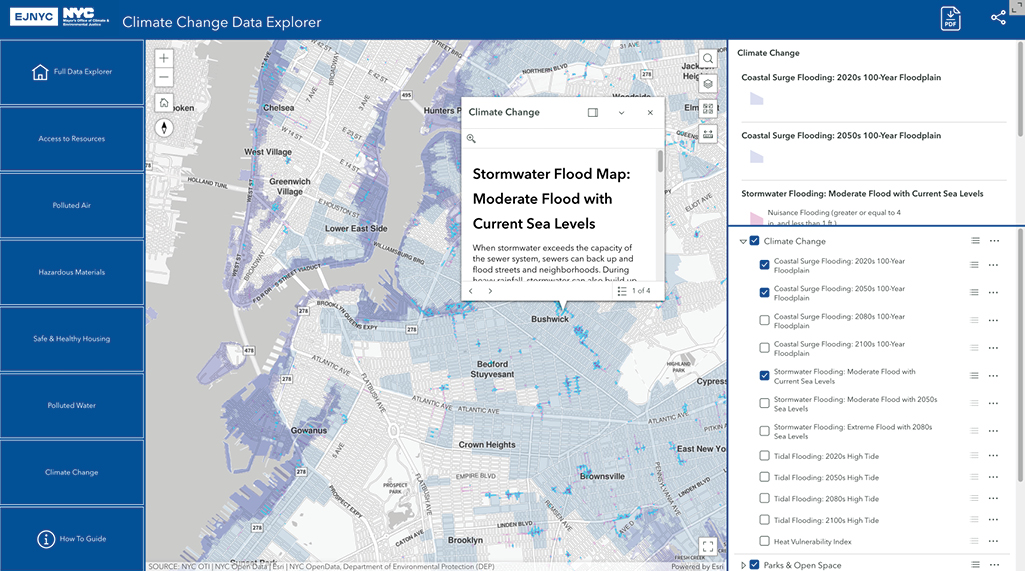What Comes Next?
Ejnyc Plan
This report’s accounting of the challenges and opportunities for environmental justice in New York City will inform the next stage in the City’s process of evaluating and addressing EJ issues. The findings are also intended to support continued mobilization across the city for community-led action on EJ issues, providing information and tools for community-based organizations and advocates to continue to advance their work. As such, the public will be invited to participate in the development of the EJNYC Plan that was legislated to be created as required by Local Law 64 of 2017 and will build off the findings in this report and identify actionable steps that City government can take to meaningfully address environmental concerns in EJ Areas. The EJNYC Plan will detail recommendations on how City agencies can design and administer their initiatives to support the ability of communities to thrive.
To lay the foundation for this process, the City identified policy opportunities to advance environmental justice based on the findings of this study. These opportunities and others will be explored further in the forthcoming EJNYC Plan. This will be a collaborative effort to develop initiatives in a holistic manner. These opportunities are to:
- Invest in environmental justice communities;
- Integrate environmental justice in agency decisions through climate budgeting;
- Improve accountability through increased data transparency and communication;
- Coordinate with permitting authorities to embed equity and environmental justice considerations in the siting and permitting of infrastructure; and
- Explore and develop new ways to collaborate with EJ communities.
Get Involved
Visit climate.cityofnewyork.us, subscribe to the newsletter for the Mayor’s Office of Climate & Environmental Justice, and follow @NYClimate or @GreeNYC to find out about future opportunities to get involved.
Environmental Justice Mapping Tool
The EJNYC Mapping Tool is an online repository of information that includes an interactive mapping and data tool, providing NYC-specific EJ data to members of the public, community-based organizations, and City agencies. The tool includes
demographic information, environmental data, health data, political boundaries, and other layers that paint a picture of the state of environmental justice and the impacts of EJ disparities in communities across the city.
Who is the EJNYC Mapping Tool For?
The EJNYC Mapping Tool is a tool developed for use by three primary groups: NYC residents, community-based organizations, and City agencies. The EJNYC Mapping Tool can inform residents of New York City about the EJ issues impacting their neighborhoods, and further direct them to resources that might help them address those issues. Community-based organizations can also use the EJNYC Mapping Tool to access and analyze data that describes the EJ concerns in their communities. The mapping tool provides CBOs with tools to visualize data and demonstrate the cumulative impacts of multiple, overlapping EJ issues in their communities. Most importantly, the mapping tool publishes new data that was previously unavailable to the public, broadening the scope and understanding of EJ in New York City. Finally, for City agencies, the mapping tool provides an EJ lens to inform policy-making. The mapping tool is designed to shift the City’s decision- making processes by ensuring that EJ remains a primary consideration in agency decisions.
How Can the EJNYC Mapping Tool Be Used?
The EJNYC Mapping Tool is designed to be used as an educational resource and research tool, and a leverage point to drive action. EJ issues are complex and multi-faceted, so the mapping tool provides educational guidance as users explore the many aspects of environmental justice. The mapping tool is designed to be approachable and accessible to all users, whether they’re EJ experts, or exploring these issues for the first time. The mapping tool also provides links to additional resources where users can learn more about the issues they’re exploring. Additionally, as a research tool, users have the ability to develop queries, and assess cumulative impacts within various political boundaries. And since the mapping tool acts as a centralized location for key EJ data for NYC, it allows for users to draw connections between disparate datasets, which are often siloed.
The EJNYC Mapping Tool also includes various ways for NYC residents, CBOs, and City agencies to drive action. For residents impacted by EJ issues and the CBOs working to combat those issues, the mapping tool provides links to access additional information and resources about City programs that address environmental injustice, so they can seek support and advocate for change. For those working within City agencies, the mapping tool provides pertinent data from other agencies, and draws connections between EJ indicators that can drive more thoughtful, inclusive decision-making, which deeply considers the interrelated impacts of City government decisions on EJ communities.




